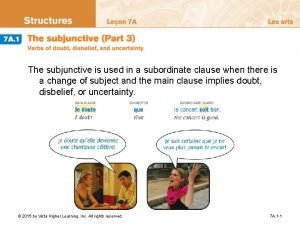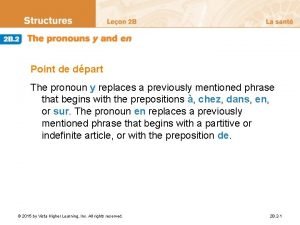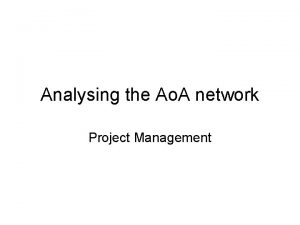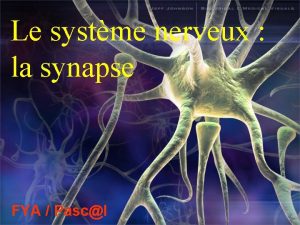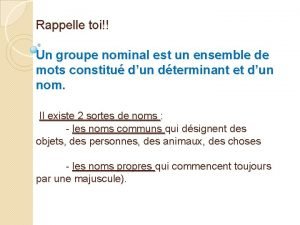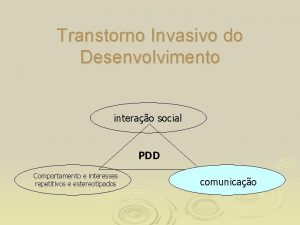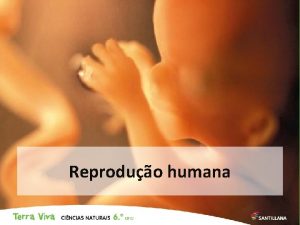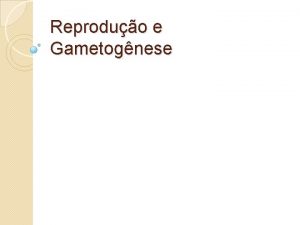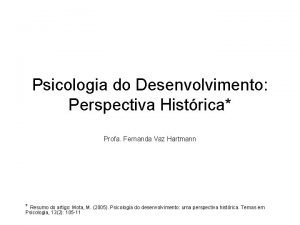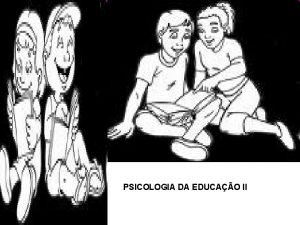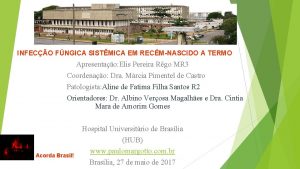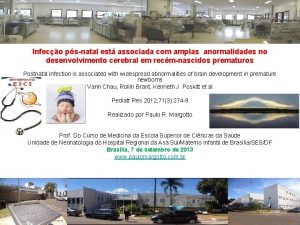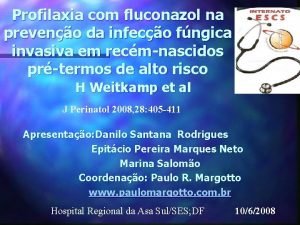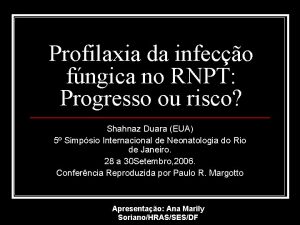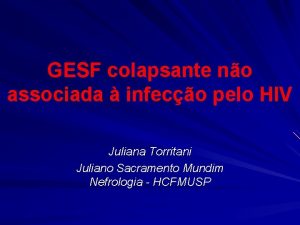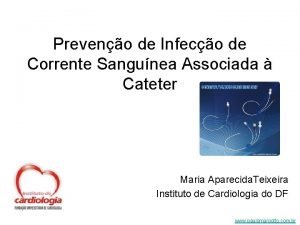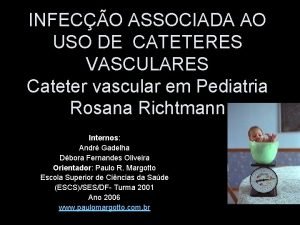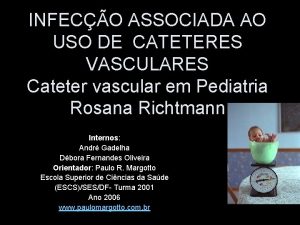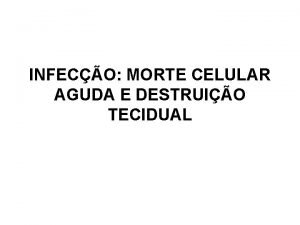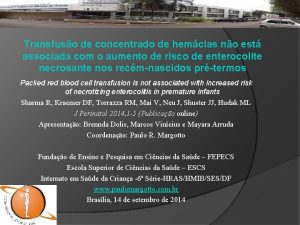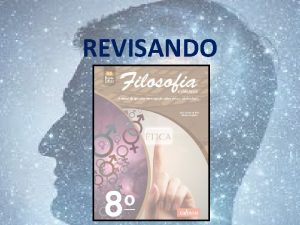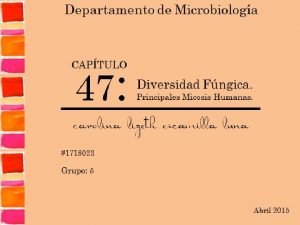Infeco fngica sistmica est associada como desenvolvimento de



























- Slides: 27

Infecção fúngica sistêmica está associada como desenvolvimento de retinopatia do prematuro em recém nascidos de muito baixo peso: uma metanálise Ivan Araújo Motta Natália Bastos Coordenação: Paulo R. Margotto Escola Superior de Ciências da Saúde/ESCS/SES/HRAS/DF www. paulomargotto. com. br Unidade de Neonatologia do HRAS

Systemic fungal infection is associated with the development of retinopathy of prematurity in very low birth weight infants: a meta-review S K Bharwani and R Dhanireddy 1 Department of Pediatrics, Division of Neonatology, University of Tennessee Health Science Center, Memphis, TN, USA Journal of Perinatology (2008) 28, 61– 66

OBJETIVOS • Por meio de um estudo sistêmico e de uma meta análise, deseja se investigar a associação entre infecção fúngica sistêmica( IFS) e o desenvolvimento de todos os graus de retinopatia do prematuro(ROP) em recém nascido de muito baixo peso(RNMBP).

Introdução • As morbidades entre os RNMBP(<1500 g) estão aumentando devido a maior taxa de sobrevivência dos recem nascidos prematuros. • As infecções são as principais morbidades, com aumento significativo da IFS. • Cândida neonatal ocorre em 1. 6 a 9% dos RNMBP e 4 a 15% dos RNMMBP.

INTRODUÇÃO • O desenvolvimento de ROP esta sendo reportado com um fator de risco independente para o desenvolvimento de ROP; • ROP requer o uso de cirurgia a laser para correção.

MÉTODOS-PROCURA LITERÁRIA • Incluiu pesquisa em “databases” como MEDLINE, EMBASE e Scopus; • Foram usadas palavras chaves, como: sepse fúngica e candidemia; • Foi feito contato com os autores de vários artigos; • Apenas artigos em inglês foi encontrado. Não foi feito procura manual; • A revisão sistemática é no formato da Meta análise of Observational Studies in Epidemiology.

MÉTODOS-SELEÇÃO DE ESTUDO • Todos estudos são estudos de coorte retrospectivos; • Estudo sem grupo controle não foram selecionados, como: relato de caso; • Foram considerados todos pacientes com ou sem ROP, com ou sem IFS; • ROP>3 foi considerada ROP severa.

MÉTODOS-EXTRAÇÃO DE DADOS • Foram cruzados dados em tabelas 2 x 2 ; • Os revisores fizeram resumos independentes dos resultados; • Quando houve diferenças, os revisores discutiram e entraram num acordo; • Juntados todos pacientes com e sem IFS e relacionado com ROP severa e “todos os graus” ROP.

MÉTODOS-TRANSFORMAÇÃO DOS DADOS E ANÁLISE • Analisados em REVIEW MANAGER 4. 2 SOFTWARE; • Expressado em risco relativo, Odds Ratio (OR), diferença de risco e NNH (número necessário para tratamento); • Intervalo de confiança de 95%; • I 2 and X 2 -tests ( I 2=[(Q–d. f. )/Q] 100%, onde Q é o X 2 -statistic e d. f. é seus graus de liberdade. Isto descreve a percentagem da variabilidade na estimativa do efeito que é devido a heterogeneidade mais do que um erro de amostra (chance). Um valor >50% pode ser considerado ter ocorrido substancial heterogeneidade.

Sumário dos Estudos Incluídos

RESULTADOS • Foram encontrados 27 estudos. Depois de analisados critérios de inclusão e exclusão foram selecionados sete trabalhos; • Há semelhanças e diferenças entre os estudos; • Todos usaram a mesma escala para ROP e são coorte retrospectivos; • Alguns estudos só tinham RNMMBP e outros tinha RNMBP e RNMMBP.

RESULTADOS • Houve diferença quanto a definição de sepse fúngica e sepse por cândida; • Apenas um estudo incluía so criança com ROP severa;

Metagráfico de Odds Ratio (OR) de todas ROP in IFS versus não IFS em RNMMBP (n: todos os pacientes com qualquer ROP; N: total de pacientes elegíveis no estudo) • 261 de 303 bebes com IFS tiveram ROP comparado com 1081 de 1648 que não tinha IFS; • Assim o risco de ter ROP foi maior em RN com IFS: (OR: 3, 40; IC de 2, 34 -4, 95; NNT: 5, 56

Metagráfico de Odds Ratio (OR) de severa ROP in IFS versus não IFS em RNMMBP (n: todos os pacientes com severa ROP; N: total de pacientes elegíveis no estudo) • • De 330 bebes com IFS, 118 tiveram ROP severa comparado com 235 de 1951 sem IFS; O risco de desenvolver ROP severa foi significativamente maior no grupo com IFS: (OR : 4, 06; IC de 3, 05 -5, 42; NNT: 4, 54)

DISCUSSÃO • Este é o primeiro estudo associando ROP e IFS em RNMBP; • Mostra que há correlação positiva entre os fatos analisados, tanto nos estudos isolados quanto nas metanálises; • O peso do trabalho está no grande numero de estudos, grande número de crianças analisadas, no rigor metodológico e no relato apropriado da revisão.

Discussão • A revisão esta expressando o resultado em risco ou benefícios prováveis que cada criança pode esta sujeita; • Tentou se minimizar o viés de informação contactando três autores; • A revisão pode ser incompleta devido ao viés de linguagem.

DISCUSSÃO • Há algumas falhas no estudo; • Todos estudos foram retrospectivos e observacionais, o que leva a erros de aferição; • Prevenir IFS diminui o risco de ROP severa em RNMBP; • Devido a forte associação deve se ter cuidado com IFS e tratar agressivamente.

DISCUSSÃO • Não se sabe ainda com a IFS leva a ROP • A Candida albicans interage com células endoteliais vasculares de várias formas, segundo Higgins JPT et al, 2003; Filler SG et al, 1996; Stone J et al, 1996; Pierre EA et al, 1995 -pode lesar vasos sanguíneos em desenvolvimento na retina que estimula citocinas próinflmatórias, tornando-os mais vulneráveis para o desenvolvimento de ROP severa (esta lesão ocorre a nível celular, o que explica a ausência de endoftalmite ao exame oftalmológico nestas crianças -induz neovascularização nos rins e cérebro (em ratos) • O exato mecanismo da indução da angiogênese pela C. albicans é desconhecido: -é possível que seja produzido alguma substância que seja responsável pela severidade da ROP -se desconhece se a candidemia modula a expressão de fatores conhecidos angiogênicos, como o fator de crescimento endotelial vascular (este tem sido implicado na patogênese da ROP).

Referências do artigo: • Stoll BJ, Hansen N, Fanaroff AA, Wright LL, Carlo WA, Ehrenkranz RA et al. Late-onset sepsis in very low birth weight neonates: the experience of the NICHD Neonatal Research Network. Pediatrics 2002; 110: 285– 291. | Article | Pub. Med | ISI | • Saiman L, Ludlington E, Pfaller M, Rangel-Frausto S, Wiblin RT, Dawson J et al. Risk factors for candidemia in neonatal intensive care unit patients. The National Epidemiology of Mycosis Survey Study Group. Pediatr Infect Dis J 2000; 19: 319– 324. | Article | Pub. Med | ISI | Chem. Port | • Fanaroff AA, Korones SB, Wright LL, Verter J, Poland RL, Bauer CR et al. Incidence, presenting features, risk factors and significance of late onset septicemia in very low birth weight infants. Pediatr Infect Dis J 1998; 17: 593– 598. | Article | Pub. Med | ISI | Chem. Port | • Stoll BJ, Gordon T, Korones SB, Shankaran S, Tyson JE, Bauer CR et al. Late-onset sepsis in very low birth weight neonates: a report from the National Institute of Child Health and Human Development Neonatal Research Network. J Pediatr 1996; 129: 63– 71. | Article | Pub. Med | ISI | Chem. Port | • Rowen JL, Atkins JT, Levy ML, Baer SC, Baker CJ. Invasive fungal dermatitis in the 1000 gram neonate. Pediatrics 1995; 95: 682 – 687. | Pub. Med | ISI | Chem. Port |

• Faix RG, Kovarik SM, Shaw TR, Johnson RV. Mucocutaneous and invasive candidiasis among very low birth weight (<1500 grams) infants in intensive care nurseries: a prospective study. Pediatrics 1989; 83: 101– 107. | Pub. Med | Chem. Port | • Bendel CM, Hostetter MK. Systemic candidiasis and other fungal infections in the newborn. Semin Pediatr Infect Dis 1994; 5: 35 – 41. • Fraser VJ, Jones M, Dunkel J, Storfer S, Medoff G, Dunagan WC. Candidemia in a tertiary care hospital: epidemiology, risk factors, and predictors of mortality. Clin Infect Dis 1992; 15: 414– 421. | Pub. Med | Chem. Port | • Klein JJ, Watanakunakorn C. Hospital-acquired fungemia: its natural course and clinical significance. Am J Med 1979; 67: 51– 58. | Article | Pub. Med | Chem. Port | • Wey SB, Mori M, Pfaller MA, Woolson RF, Wenzel RP. Hospital acquired candidemia: the attributable mortality and excess length of stay. Arch Intern Med 1988; 148: 2642– 2645. | Article | Pub. Med | Chem. Port | • Kaufman D, Boyle R, Hazen KC, Patrie JT, Robinson M, Donowitz LG. Fluconazole prophylaxis against fungal colonization and infection in preterm infants. N Engl J Med 2001; 345: 1660– 1666. | Article | Pub. Med | Chem. Port |

• Mittal M, Dhanireddy R, Higgins RD. Candida sepsis and association with retinopathy of prematurity. Pediatrics 1998; 101: 654– 657. | Article | Pub. Med | ISI | Chem. Port | • Manzoni P, Maestri A, Leonessa M, Mostert M, Farina D, Gomirato G. Fungal and bacterial sepsis and threshold ROP in preterm very low birth weight neonates. J Perinatol 2006; 26: 23– 30. | Article | Pub. Med | ISI | Chem. Port | • Noyola DE, Bohra L, Paysse E, Fernandez M, Coats DK. Association of candidemia and retinopathy of prematurity in very low birth weight infants. Ophthalmology 2002; 109: 80– 84. | Article | Pub. Med | ISI | • Parupia H, Dhanireddy R. Association of postnatal dexamethasone use and fungal sepsis in the development of severe retinopathy of prematurity and progression to laser therapy in extremely low–birth-weight infants. J Perinatol 2001; 21: 242– 247. | Article | Pub. Med | • Tadesse M, Dhanireddy R, Mittal M, Higgins RD. Race, candida sepsis, and retinopathy of prematurity. Biol Neonate 2002; 81: 86– 90. | Article | Pub. Med | ISI |

• Sanchez V, del Moral T, Claure N, Vanbuskirk S, Flynn J, Bancalari E. Sepsis as a risk factor for the development of retinopathy of prematurity in extremely low birth weight infants. Pediatr Res 2002; 51: 367 A. • Karlowicz GM, Giannone PJ, Pestian J, Morrow AL, Shults J. Does candidemia predict threshold retinopathy of prematurity in extremely low birth weight ( 1000 g) neonates? Pediatrics 2000; 105: 1036– 1040. | Article | Pub. Med | ISI | Chem. Port | • Stroup DF, Berlin JA, Morton SC, Olkin I, Williamson DG, Rennie D et al. Meta-analysis of observational studies in Epidemiology. JAMA 2000; 283: 2008– 2012. | Article | Pub. Med | ISI | Chem. Port | • Friedman S, Richardson SE, Jacobs SE, O'Brien K. Systemic Candida infection in extremely low birth weight infants: short term morbidity and long term neurodevelopmental outcome. Pediatr Infect Dis J 2000; 19: 499– 504. | Article | Pub. Med | Chem. Port | • Higgins JPT, Thompson SG. Quantifying heterogeneity in a metaanalysis. Stat Med 2002; 21: 1539– 1558. | Article | Pub. Med | ISI | • Higgins JPT, Thompson SG, Deeks JJ, Altman DG. Measuring inconsistency in meta-analyses. BMJ 2003; 327: 557– 560. | Article | Pub. Med |

• An international classification of retinopathy of prematurity. Pediatrics 1984; 74: 127. | Pub. Med | • Dickersin K. Systematic reviews in epidemiology: why are we so far behind? Int J Epidemiol 2002; 31: 6– 12. | Article | Pub. Med | • Bollen CW, Hoekstra MO, Arets HGM. Pooling of studies in metaanalysis of observational research leads to precise but spurious results. Pediatrics 2006; 117: 261– 262. | Article | Pub. Med | Chem. Port | • Filler SG, Swerdloff JN, Hobbs C, Luckett PM. Penetration and damage of endothelial cells by Candida albicans. Infect Immunol 1995; 63: 976– 983. | Chem. Port | • Filler SG, Ibe BO, Luckett PM, Raj JU, Edwards Jr JE. Candida albicans stimulates endothelial cell eicosanoid production. J Infect Dis 1991; 164: 928– 935. | Pub. Med | Chem. Port | • Filler SG, Pfunder AS, Spellberg BJ, Spellberg JP, Edwards Jr JE. Candida albicans stimulates cytokine production and leukocyte adhesion molecule expression by endothelial cells. Infect Immunol 1996; 64: 2609– 2617. | Chem. Port | • Stone J, Chan-Ling T, Pe'er J, Itin A, Gnessin H, Keshet E. Roles of vascular endothelial growth factor and astrocyte degeneration in the genesis of retinopathy of prematurity. Invest Ophthalmol Vis Sci 1996; 37: 290– 292. | Pub. Med | ISI | Chem. Port | • Pierce EA, Avery RL, Foley ED, Aiello LP, Smith LEH. Vascular endothelial growth factor/vascular permeability factor expression in a mouse model of retinal neovascularization. Proc Natl Acad Sci USA 1995; 92: 905– 909. | Article | Pub. Med | Chem. Port |

Mais artigos como este: • Systemic fungal infection is associated with the development of retinopathy of prematurity in very low birth weight infants: a meta-review • Journal of Perinatology Original Article • Fungal and bacterial sepsis and threshold ROP in preterm very low birth weight neonates • Journal of Perinatology Original Article • Very Low Prevalence of Endophthalmitis in Very Low Birthweight Infants who Survive Candidemia • Journal of Perinatology Original Article • Cumulative illness severity and progression from moderate to severe retinopathy of prematurity • Journal of Perinatology Original Article • See all 21 matches for Research

Consultem também: • ROP-Retinopatia da Prematuridade Autor(es): Joseneide Mª F. de Oliveira

• Retinopatia da prematuridade Autor(es): Rosângela Cândido Marinho, Nilcéia P. Lessa

Obrigado! Dda Natália, Dr. Paulo R. Margotto, Ddo Ivan Motta
 Sobre uma mesma trajetória associada ao piso
Sobre uma mesma trajetória associada ao piso Uftm mg sobre uma mesma trajetoria associada ao piso
Uftm mg sobre uma mesma trajetoria associada ao piso Como começar o desenvolvimento
Como começar o desenvolvimento Qui est mignon
Qui est mignon Il est douteux que le metteur en scène où est l’acteur.
Il est douteux que le metteur en scène où est l’acteur. Lapereau bouquin
Lapereau bouquin Papa est au garage? oui, il
Papa est au garage? oui, il Le grain qui meurt a porté fruit partition
Le grain qui meurt a porté fruit partition Je suis il est tu es
Je suis il est tu es Qu'est ce que c'est
Qu'est ce que c'est Est eft lst lft
Est eft lst lft Seul le silence est grand tout le reste n'est que faiblesse
Seul le silence est grand tout le reste n'est que faiblesse Mon dieu, tu es grand, tu es beau paroles pdf
Mon dieu, tu es grand, tu es beau paroles pdf Je veux crier mon dieu
Je veux crier mon dieu Je suis tu es elle est
Je suis tu es elle est Kochelsee
Kochelsee Qu'est ce que c'est
Qu'est ce que c'est Ce n'est pas une image juste c'est juste une image
Ce n'est pas une image juste c'est juste une image Exemple de gn
Exemple de gn Verbe detat
Verbe detat Verbes qui exigent le subjonctif
Verbes qui exigent le subjonctif Transtorno invasivo do desenvolvimento o que é
Transtorno invasivo do desenvolvimento o que é Anexos embrionário
Anexos embrionário Partenogênese
Partenogênese Desenvolvimento indireto exemplos
Desenvolvimento indireto exemplos Psicologia do desenvolvimento uma perspectiva histórica
Psicologia do desenvolvimento uma perspectiva histórica Aspecto do desenvolvimento humano
Aspecto do desenvolvimento humano Piaget wallon
Piaget wallon




